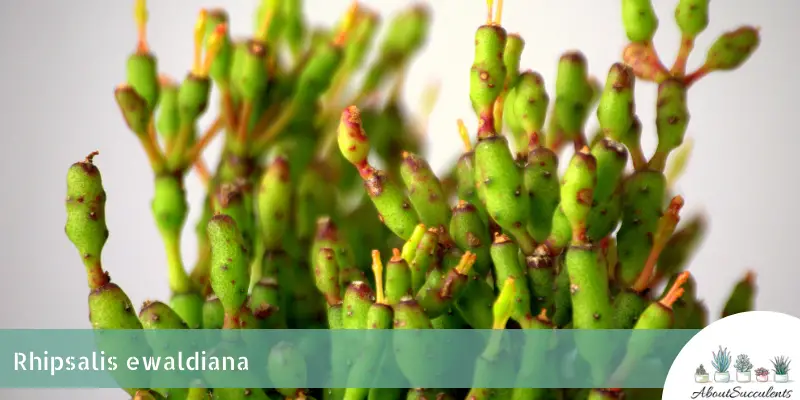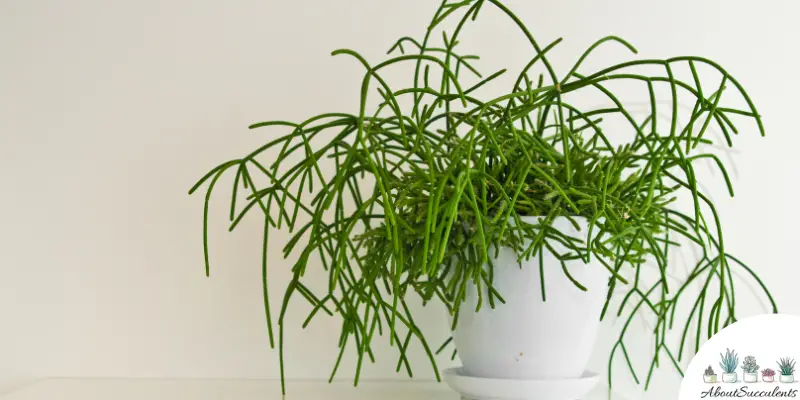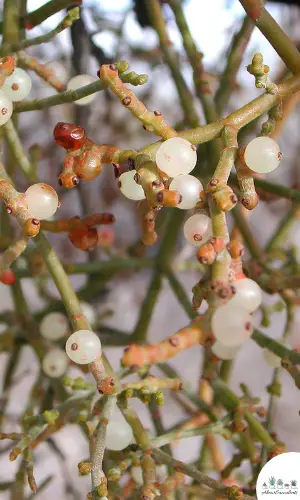
Rhipsalis Ewaldiana, also known as Mistletoe Cactus, is a spineless epiphytic (tree-dwelling) cactus with unique-looking trailing foliage. that strikingly resembles green waterfalls. In its natural habitat, this plant can be found clinging to tree crotches or branches.
Mistletoe Cactus has pencil-thin, deep green, triangular, branching stems that can reach the length of 61cm (24”) and width of 30.5cm(12”). The stems are donned with barely visible pale brown thorn-like bumps.
During Spring and Fall, the Mistletoe Cactus blooms small white flowers. Rhipsalis Ewaldiana is native to Brazil. It is part of the Rhipsalis genus from the Cactaceae family.
General Information
Also known as: Mistletoe Cactus
Plant Family: Cactaceae
Origin: Brazil
Height: 61cm (24”)
Exposure: Full or partial sun; up to 6 hours.
Water needs: Not drought-resistant; water the soil when it is surface dry
Soil type: Cacti mix combined with mineral grit such as coarse sand, perlite, and pumice.
Soil pH: 5.0 to 6.5
How to Grow and Care for Rhipsalis Ewaldiana

Growing and caring for Rhipsalis ewaldiana is very easy. Once you learn how to mimic the living conditions of its natural habitat, your plant will thrive well with little attention.
Many succulent growers use the Mistletoe Cactus as indoor hanging plants because of its beautiful long trailing stems. It can also be mounted on a piece of bark similar to growing orchids.
Rhipsalis ewaldiana is not cold-hardy and will not survive at temperatures below -1.1°C (30°F).
Sunlight
In its native habitat, Rhipsalis ewaldiana is used to receiving bright light filtered by the dense tree branches. Keep in mind that replicating its native living conditions is the key to your plant’s good health.
If grown outdoors, make sure to place it in a location where it will get plenty of morning sun and full shade in the afternoon for 5 to 6 hours a day. Exposure to direct sunlight will burn the stems while insufficient lighting will stunt its growth.
If grown indoors, place your pots near north or west-facing windows. If your windows at home receive midday or afternoon sun, place your pots 50cm (20”) away to prevent sunburn.
Watering
Rhipsalis ewaldiana is not a drought-resistant succulent. You need to water your plant regularly but avoid over-soaking the soil to prevent root rot and weakening of the stems. It is best to use soft water or rainwater because this plant is sensitive to lime.
Make sure that the soil is surface dry or 2” deep dry before you water again. Water frequently in summer and spring when it is actively growing. Taper off watering during winter, when Rhipsalis ewaldiana is in its dormant phase.
Mistletoe Cactus thrives well in humid climates because its natural habitat is the rainforest. Many Rhipsalis indoor growers use humidifiers during winter when the humidity level is at its lowest.
Pot and Soil
The best kind of pot to use for Rhipsalis ewaldiana is made with terracotta or ceramic. This will allow proper soil aeration and prevent water retention. Make sure to get pots with drainage holes to prevent root rot.
The ideal soil mix for your Mistletoe Cactus is cactus potting soil combined with mineral grit such as coarse sand, perlite, or pumice.
Since this plant is epiphytic, it does not require plenty of soil. It only needs to be buried deep enough to allow the shallow roots to get steadily anchored.
Rhipsalis ewaldiana will benefit from regular feeding of diluted fertilizer. Feed your plant every two weeks during summer and spring when it is actively growing. Suspend feeding during its dormant phase in winter.
How to Propagate Rhipsalis Ewaldiana

Rhipsalis ewaldiana can be propagated using its stem cuttings. Keep in mind that the best time to propagate using cuttings is during spring and summer.
Method 1 – Stem Cuttings
Step 1: Use a sterilized sharp knife or pruning shears to separate healthy 8cm – 15cm (3.14” – 5.90”) long shoots.
Step 2: Leave the cuttings in a partially shaded and dry area for 3 to 5 days to allow the wounds to seal and for the calluses to develop.
Step 3: After the cuttings have calloused over, plant them in terracotta or ceramic pots filled with cactus mix and mineral grit.
Step 4: Place the pots in a partially shaded area. Keep the soil slightly moist. You can also cover the pots with transparent plastic bags to increase humidity.
Step 5: Ventilate every day to prevent mold growth. Once the roots have been established remove the plastic cover.
Frequently Asked Questions
Is Rhipsalis Ewaldiana Toxic to Cats and Dogs?
Rhipsalis ewaldiana is not listed as a plant that’s toxic to cats, dogs, and horses on the website of the American Society for the Prevention of Cruelty to Animals (ASPCA).
Why is My Rhipsalis Ewaldiana Dying?
If your Mistletoe Cactus is showing telltale signs of illness, you need to treat it right away before it is too late to revive it. The possible causes of your plant’s sickness are overwatering and pest infestation.
Overwatering
Letting your plant sit in very damp soil for long periods will cause its roots to rot. The good news is that you can still save your overwatered Mistletoe Cactus if you detect the problem early on.
Look for signs of discoloration or the appearance of black spots on the plant. When discoloration occurs, the infection is making its way out of Mistletoe Cactus.
You have to cut off the infected parts with a sterilized pair of scissors or knife before it contaminates other sections of the Rhipsalis ewaldiana.
Always sterilize the cutting tool with a piece of cotton that’s been soaked in 70% alcohol after every use. Traces of the fungi might be on the knife or scissors.
Carefully remove your plant from the pot. Shake off all the soil clinging to the roots. Examine the stems and the roots and cut all the damaged parts with the sterilized knife or garden shears.
Leave your plant in a dry area while you prepare to repot. Fill a ceramic or terracotta pot with fresh cactus mix and mineral grit. Repot your Mistletoe Cactus and wait 5 days before you water the soil.
Pest Infestation
Mealybugs, aphids, red spiders, and other scale insects love to feast on Rhipsalis ewaldiana. To get rid of these sap-sucking pests, remove the plant from the pot and wash it under a strong stream of water.
Wash the pot thoroughly in hot, soapy water and let it dry out before you fill it with fresh potting mix. Replant your Mistletoe Cactus and throw away the old potting soil.
Spray your plant with 70% rubbing alcohol, diluted neem oil, or soapy water. Do not forget to spray in between stems where mealybugs love to hide. Avoid exposure to sunlight after treatment.
Repeat treatment every week until you get rid of all the mealybugs. Make sure to isolate your infected plant during treatment.
Yes, Rhipsalis ewaldiana blooms small, white flowers in spring and summer.
Last Updated on June 9, 2022 by Sofia Lara